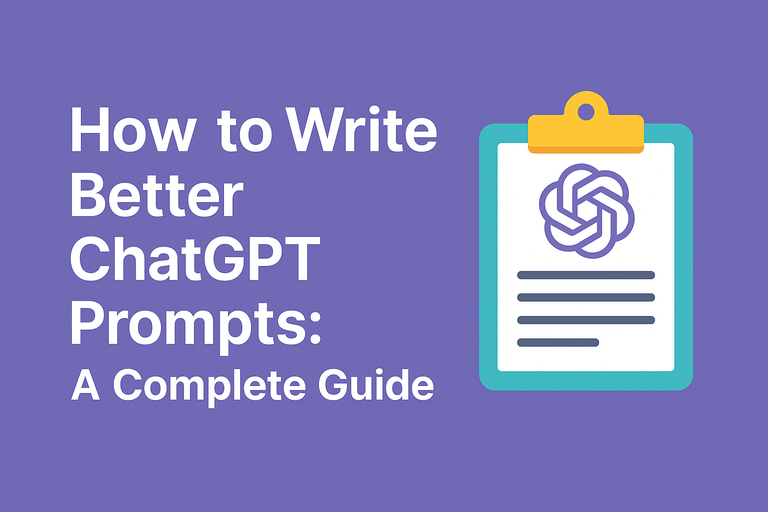How to Write Better ChatGPT Prompts: A Complete Guide
Estimated reading time: 8 minutes
Key Takeaways
- Clear, structured prompts lead to higher-quality AI responses.
- Understand the six core components of effective ChatGPT prompts: Role, Request, Context, Format, Examples, Constraints.
- Adopt proven best practices: precise language, iterative refinement, and providing context.
- Follow a simple 5-step tutorial to get started as a beginner.
- Elevate your skills with advanced techniques like rule implementation and self-critique.
Understanding ChatGPT Prompt Structure
Before diving into advanced techniques, let’s break down what a prompt actually is. A prompt is simply the text or instruction you feed to ChatGPT to get a response. Crafting effective ChatGPT prompts requires understanding six core components:
- Role/Characterization – Assigns ChatGPT a specific persona (You are an expert chef).
- Request/Command – The specific action you want ChatGPT to perform, such as “Explain,” “Generate,” or “Analyze.”
- Context/Background – Relevant details like constraints or scenarios that inform the response.
- Output Format – Desired structure (bullet points, tables, paragraphs, etc.).
- Examples (Optional) – Sample outputs showing preferred style or tone.
- Rules or Constraints – Word limits, style guidelines, or content restrictions to keep responses focused.
Source: Coursera on writing ChatGPT prompts, LearnPrompting basics of prompt structure, FVIVAS prompt formulas and structures.
Crafting Effective ChatGPT Prompts
The cornerstone of success with ChatGPT lies in clarity and specificity. Here’s a detailed strategy breakdown:
-
Precise Language
- Avoid vague terms like “nice” or “good.”
- Use specific, measurable descriptors.
- State exactly what you want.
-
Format Specification
- Clearly state desired output format.
- Include length requirements.
- Specify structural elements.
-
Task Breakdown
- Split complex requests into smaller steps.
- Use numbered or bulleted instructions.
- Create logical flow between subtasks.
-
Example Integration
- Provide samples when style matters.
- Include templates for formatting.
- Show preferred tone through examples.
-
Iterative Refinement
- Test initial prompts.
- Analyze responses.
- Adjust based on results.
- Keep refining until perfect.
Source: OpenAI Prompt Engineering Best Practices, Coursera on writing ChatGPT prompts.
Best Practices for ChatGPT Prompts
Follow these proven best practices to maximize your results:
- Role Assignment – Always specify ChatGPT’s role (Prompt Engineering Jobs in high demand).
- Clear Objectives – State precise goals, define scope clearly, and set measurable outcomes.
- Contextual Information – Provide relevant background, include necessary facts, establish important parameters.
- Output Guidelines – Specify desired style, required tone, and length requirements.
- Iterative Improvement – Review initial outputs, identify areas for improvement, refine prompts accordingly.
Beginner Prompt Tutorial
Follow this simple 5-step process to create effective prompts:
-
Step 1: Define Your Goal
- What specific outcome do you want?
- What problem are you solving?
- What information do you need?
-
Step 2: Describe the Task
- Write clear instructions.
- Use action words.
- Be specific about requirements.
-
Step 3: Specify Output Format
- Choose appropriate format (list, table, text).
- State length requirements.
- Define structure needs.
-
Step 4: Provide Context
- Include relevant background.
- Add example outputs if needed.
- Share important constraints.
-
Step 5: Test and Refine
- Run your prompt.
- Analyze the response.
- Make necessary adjustments.
Source: Coursera on writing ChatGPT prompts.
Advanced Tips for Refining Prompts
-
Rule Implementation
- Set strict word limits.
- Define formatting requirements.
- Establish content boundaries.
-
Self-Critique Requests
- Ask ChatGPT to evaluate its response.
- Request improvements.
- Seek alternative approaches.
-
Layered Instructions
- Break down complex tasks.
- Create sequential steps.
- Build comprehensive outputs.
-
Troubleshooting Strategies
- Identify unclear elements.
- Add clarifying details.
- Resolve ambiguity.
-
Continuous Improvement
- Monitor response patterns.
- Track effective approaches.
- Refine successful templates.
Source: OpenAI Prompt Engineering Best Practices.
Case Studies and Examples
Real-World Example 1: Financial Advisor Prompt
Prompt: “As a financial advisor, summarize the key risks and rewards of investing in emerging markets for a beginner investor. Provide a simple comparison table.”
Analysis:
- Clear role definition.
- Specific audience focus.
- Structured output request.
- Practical application.
Real-World Example 2: Creative Writing Prompt
Prompt: “You’re a sci-fi novelist. Draft a 200-word scene set on a Mars colony under siege.”
Analysis:
- Defined genre and role.
- Specific word count.
- Clear setting and scenario.
- Creative parameters.
Conclusion
Mastering how to write better ChatGPT prompts is a game-changing skill in today’s AI-driven world. By implementing the structures, practices, and techniques covered in this guide, you’ll consistently generate more accurate, relevant, and valuable AI responses.
Remember to:
- Follow proper prompt structure.
- Maintain clarity and specificity.
- Apply best practices consistently.
- Use the beginner tutorial as needed.
- Implement advanced techniques gradually.
- Learn from real-world examples.
Additional Resources
- OpenAI’s Official Guide to Prompt Engineering
- Coursera’s Article on Writing ChatGPT Prompts
- LearnPrompting Basics of Prompt Structure
- FVIVAS Prompt Formulas and Structures
Frequently Asked Questions
What are the six core components of an effective ChatGPT prompt?
The six core components are Role/Characterization, Request/Command, Context/Background, Output Format, Examples (optional), and Rules or Constraints.
How can I improve the clarity of my ChatGPT prompts?
Use precise language, break tasks into smaller steps, specify formats, and provide relevant context or examples.
What is the 5-step beginner process for crafting prompts?
Define your goal, describe the task, specify output format, provide context, then test and refine your prompt.
How do advanced techniques elevate prompt quality?
Advanced techniques like implementing strict rules, requesting self-critiques, layering instructions, and troubleshooting add precision and depth to your prompts.
